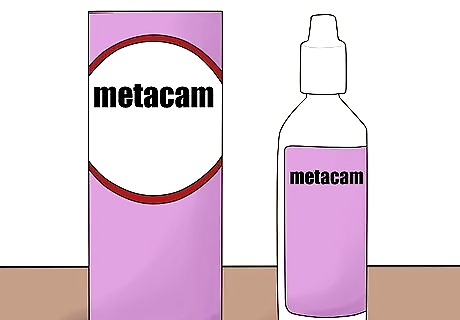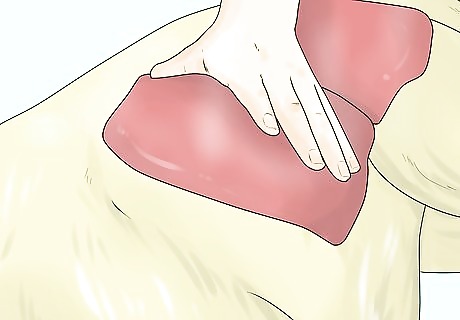
views
Using Massage

Learn about dog massage. Giving your dog a massage may help to provide stress relief, better circulation, and pain relief. It is also a great way to bond with your dog and it may even help you to detect injuries or other health conditions that may require treatment. Massage is a recognized therapy with beneficial effects that is advocated and practiced by veterinary physiotherapists.

Know when massage should not be done. A massage is not always the answer to your dog’s pain. In some cases, a massage may make your dog feel worse. You should not massage your dog if he has: a broken or dislocated hip an infection in the joint a skin infection cancer If you suspect any of these conditions, take your dog to visit your veterinarian right away. These are ailments that need immediate medical treatment by a professional.

Get your dog on his side with the bad hip exposed. This shouldn't be too hard as he'll likely lay on this side anyway in an effort to keep weight off the affected hip. When you touch the area, you may notice that it's stiff and tense even when it's not being used. This is a good sign that massage can be effective. As long as the skin or bone isn't broken, massage can help alleviate your pup's pain. However, if you notice any skin issues or if your dog is audibly in pain, skip the massage and go straight to your vet for a physical assessment.

Massage your dog's hip with the flat of your palm. In a rocking motion, apply pressure with the heel of your hand, working upwards towards the heart. Slow and gentle movements are soothing; hard and fast movement stimulates. For pain relief, 1 motion every 5 seconds is ideal. Massage the affected limb for 10 to 20 minutes, two to three times a day. An animal with hip pain will have tense, stiff muscles. The tension in the muscles compresses the joint, making inflamed surfaces rub together, causing further pain. Massage not only helps the muscles to relax, but it also stimulates the release of endorphins – a natural painkiller with a similar chemical composition to morphine.

Work upwards from the extremity. To make sure you're massaging the hip correctly, imagine massaging fluid back towards the heart. Working the opposite direction forces blood to pool which can lead to swelling and reduced mobility. It also feels better for your dog to stretch the muscles up instead of forcing them down.
Using Passive Mobilization

Consider using passive mobilization. Passive mobilization is similar to stretching. Passive mobilization of a hip joint involves gently stretching the affected hind leg backwards, away from the head. Passive mobilization uses gentle limb extensions with the aim of keeping muscles conditioned and joints mobile. The theory behind passive mobilization is that pain restricts the movement of the leg, but then the hip joint becomes stiff, and this leads to a further loss of movement, and the vicious cycle continues until the joint becomes chronically painful and stiff.

Decide how to position your dog. You can use passive mobilization with the dog in a standing or lying down position. If both hips are sore it is better to have the dog lie down since he will be uncomfortable taking extra weight on the opposite hip when one leg is raised. Try placing a small pillow between your dog’s legs to make him even more comfortable.

Lay your dog on his good side. To use passive mobilization to stretch the left hip, lay the dog on his right side, with the left leg uppermost. For the right hip, lay the dog on his left side, with his right leg uppermost. This will likely be the position he's most comfortable in anyway. Laying on the opposite side takes the weight and pressure off the bad hip.

Begin pushing the thigh backwards. Slide your left hand in front of the thigh halfway down the thigh bone, and cup the cranial muscles in your left palm. Apply gentle but firm pressure so as to push the thigh backwards so that the dog's paws moves backwards, too. Do not force the movement, and stop if the dog gets uncomfortable. You're not trying to improve his flexibility, you're trying to stretch the already taut, stiff muscle.

Hold this extended position for around 40 seconds and then release. Try to do this for two ten minute sessions a day. This helps keep the joint supple and relieves pain. Mobilization is the action of passively extending a limb with the aim of keeping the muscle conditioned and the joint mobile. The theory behind mobilization is that pain restricts the movement of the leg, but then the hip joint becomes stiff, and this leads to a further loss of movement, and a downward cycle of under-use established.
Using Medical Therapy

Start your dog on NSAIDs. Non-steroidal anti-inflammatory drugs (NSAIDs) are prescription painkillers that reduce inflammation. They work by inhibiting the "bad" COX-2 enzymes that mediate joint inflammation, whilst they have smaller effects on the "good" COX-1 enzymes that maintain blood flow to the kidney and stomach lining. In short, they can reduce your dog's pain and inflammation. These drugs have a high safety margin when used correctly and are less likely to cause unpleasant side effects such as gastric ulceration and bleeding disorders when compared to other painkillers. NSAIDs that are often prescribed by veterinarians are meloxicam (Metacam), carprofen (Rimadyl), and robenacoxib (Onsior). The maintenance dose of metacam is 0.05mg/kg by mouth, with or after food, once daily. The oral suspension contains 1.5mg/ml; a typical 30kg Labrador requires 1ml daily on his food.

Give your dog aspirin. Aspirin (acetylsalicylic acid) can provide mild to moderate pain relief. If no other pain relief is available, a healthy dog may take aspirin at the dose of 10mg/kg twice a day, with or after food. Aspirin commonly comes in 300mg tablets, so a typical dose for a 66lb Labrador would be one tablet twice a day with food. However, long-term use is associated with gastric ulceration, especially when given on an empty stomach. This happens because aspirin reduces blood flow to the gut lining, stomach, and kidney. Buffered aspirin may help with this problem, but aspirin should still be used sparingly in a dog. If your dog requires frequent doses to control its pain, ask your veterinarian to examine your dog and prescribe one of the safer NSAID’s. Aspirin should never be given in addition to an NSAID medication. When combined, both drugs are even more likely to cause gastric ulceration with serious consequences, including sudden death.

Consider acetaminophen. Acetaminophen, or Tylenol can be given to dogs. However, take care when dosing because exceeding the recommended dose overloads the liver with a toxic metabolite called N-acetyl-p-aminobenzoquinonimine, which can cause liver damage, and ultimately liver failure. The dose is 10mg/kg by mouth, twice a day, with or after food. Most tablets are 500mg and so a 66 pound Labrador can take a maximum of 3/5 of a tablet twice daily. If in doubt, always give a lower dose. For small dogs, only use the children’s suspension to avoid overdosing the dog. EXPERT TIP Ray Spragley, DVM Ray Spragley, DVM Veterinarian Dr. Ray Spragley is a Doctor of Veterinary Medicine and the Owner/Founder of Zen Dog Veterinary Care PLLC in New York. With experience in multiple institutions and private practices, Dr. Spragley’s specializations and interests include non-surgical management of cranial cruciate ligament tears, Intervertebral Disk Disease(IVDD), and pain management in osteoarthritis. Dr. Spragley holds a BS in Biology from SUNY Albany and has a Doctor of Veterinary Medicine degree (DVM) from Ross University School of Veterinary Medicine. He is also a Certified Canine Rehabilitation Therapist (CCRT) through the Canine Rehab Institute as well as a Certified Veterinary Acupuncturist (CVA) through Chi University. Ray Spragley, DVM Ray Spragley, DVM Veterinarian Treat hip pain in older dogs. Ease worsening hip pain in aging dogs through joint supplements with compounds like glucosamine and chondroitin. Alternative treatments like acupuncture or laser therapy may also help. For severe arthritis, prescriptions like nerve or muscle relaxant medications, steroids, or even surgery could be warranted.
Using Physiotherapy

Use heat. The application of heat helps dilate blood vessels and stimulates circulation to the hip. In turn, this helps remove noxious toxins that irritate pain receptor nerves. Just be careful you don't burn your dog – always test it on your skin first to make sure it's a safe temperature. A simple method is to use a wheat bag – the sort you heat up in a microwave. Follow the manufacturer's instructions to heat the bag, and with the dog lying down so that the sore hip is accessible, rest the warmed wheat bag over the hip. Leave it there for 10 to 15 minutes, and then follow with some passive movement exercises.

Ask your veterinarian about Transcutaneous Nerve Stimulation (TNS). This treatment involves the application of a small electrical current to the skin in order to numb sensory nerves and block pain transmission. It does this by stimulating delta fibers that release enkephalin in the spinal cord, which in turn reduces sensitivity to pain. Veterinarians often administer this type of treatment after surgery to help with the pain, but the effects only last for about an hour.

Find a veterinarian trained to provide laser acupuncture. Veterinarians who are trained in traditional Chinese veterinary medicine (TCVM) can provide laser acupuncture treatments to your dog to help relieve hip pain. The laser stimulates the release of your dog’s body’s own pain relieving chemicals. Ask your veterinarian for a referral if you are interested in this treatment option.




















Comments
0 comment